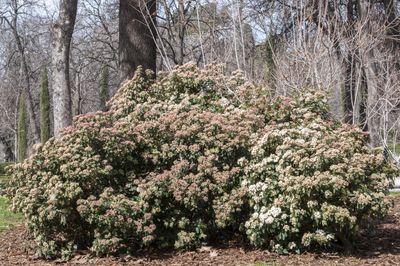Laurustinus Plant Information
Laurustinus viburnum is one of the short viburnum species, and even unpruned specimens rarely exceed 12 feet (3.6 m.) in height. Some cultivars, like Laurustinus Spring Bouquet, are much shorter. The dwarfed height is one of the key features that makes growing laurustinus shrubs popular. A gardener seeking a short hedge won’t need to prune every other week to keep the plant the right size. Laurustinus plant information states that these evergreen shrubs produce flower buds as early as January. The buds are pink or red, but the flowers open white. If you are growing Laurustinus shrubs, you’ll see the flowers give way to blue-black drupes. These viburnum drupes look like berries.
Growing Laurustinus Shrubs
If you live in a warm region, it’s easy to grow Laurustinus viburnum shrubs. They thrive in full sun but accept less, thriving even in dappled shade. Plant these bushes where the soil drainage is good. Other than requiring good drainage, Laurustinus shrubs are very tolerant of various soil types, including sand and even clay. Laurustinus are known to be drought tolerant, but the shrubs bloom more profusely with a little extra irrigation. And don’t forget to provide water during the months that follow planting.
Laurustinus Spring Bouquet
The most popular cultivar of this viburnum is Laurustinus Spring Bouquet. This cultivar thrives in U.S. Department of Agriculture plant hardiness zones 8 through 10 in shade or sun. As previously stated, it is a dwarf cultivar. Each plant grows only to four feet tall, but can get as wide as it is tall. It too sets its buds in winter, producing flattened clusters of small, pink balls that look like berries. As April rolls around and the air warms, these pink balls open up into fragrant white flowers. They smell like honey. By June, the blossoms are done flowering. They drop petals and give way to metallic blue berries.
